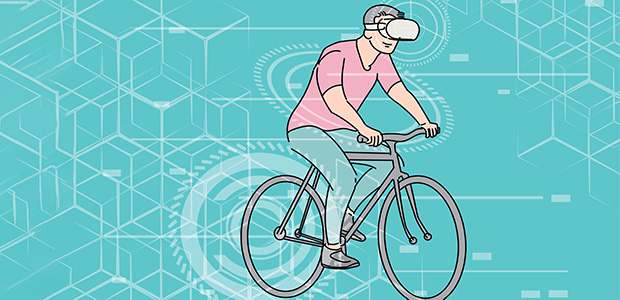
Fit Immersion: outdoor exercise, inside
The idea of VR and exercise may seem either unfamiliar or incompatible to some, but the fact is the immersion VR offers can lend to some convincing scenery for avid cyclist to take a workout in. Imagine, it’s Monday, you live in central Paris, you get home from work at six o’clock; you’re a 25-minute, one-way journey from your nearest park, perhaps it’s also raining too. So many hurdles present themselves before you have even committed to go for a ride that for some, the easier option to not go may win them over.
This article originally appeared in the March/April issue of Startups Magazine. Click here to subscribe
That is where Fit Immersion comes in. “We’re not trying to replace outdoor exercise, we’re giving people an alternative solution when it's not possible to go outside due to weather or time constraints,” says company CEO Dimitri Prikhodko. Fit Immersion arose out of a combination of Prikhodko’s skills and passion. The Founder has been involved with computer sciences and even AI since he took up a master’s degree in the topic, and the fact that he placed in or around the top 10 in France for cross country running at one point, it makes sense why he would go on to marry the two.
Having started development in 2017, Fit Immersion has traversed a lot of ground since its founding, but as Dimitri told us, there’s a lot more legs to this journey.
See the sights from your home!
Fit Immersion is a VR programme that takes users on an immersive, 360° cycling journey through a number of different tracks across the world. Users can download the programme via a VR headset like the Oculus and then, through the use of their home exercise bike, they can cycle and move through the track as they would in real life. It matches user pedal with the speed the user experiences the feed through a sensor that can be bought as part of a package from the company and placed on the pedals. However, the programme also works with smart bikes, and offers additional immersion elements, like increasing the resistance when the track begins going uphill.
Although the main sell of Fit Immersion is the software, the company recognised that currently a couple of issues exist with working out with a headset on. “Almost all VR headsets today are completely closed,” says Prikhodko. “This is obviously to stop the light coming inside but the problem is that sweat builds up, which not only makes it uncomfortable, but means the lenses can become foggy and also increase the need to clean.”
Therefore, although they don’t manufacture their own hardware, they have curated items, like a VR headset with ventilation space, from their suppliers and packaged them into ready to go bundles to optimise customers’ experience with Fit Immersion.
Currently, the app has over 30 tracks in its library for users to experience, with average length being 10km. The feed for the tracks is initially recorded in 4k, with a 360° camera, so the quality lends to the immersion.
VR you ready?!
It was a long journey, but as 2020 rolled around, the company launched for commercial development. Yet, I’m sure you don’t need detailed reminding of what occurred during this time. “The problem was that this was originally developed mainly for gyms,” Prikhodko said. “Yet, luck would have it, we were also beginning to develop the product for individual consumers, but I suppose this just kicked up development.” Covid forced the company to go heavily into the private consumer market whilst public spaces like gyms remained shut. Yet, luckily for them, home workout purchases increased massively as a result, and for people mandated to stay inside, any experience that could give them the feeling of the outside world was thus greatly sought after.
Yet there were many similar players in the space, not to mention Peloton, which offers a similar cycle through scenery experience via its onboard screen. Yet Prikhodko believes the difference between Fit Immersion’s and Peloton’s is different. “It’s not the same experience cycling and looking into a screen and cycling where you can really look around and feel like you're really present in this place.”
And it seems industry would agree with him. CNES, the “French equivalent of NASA” as Prikhodko puts it, saw utility in this solution for keeping their astronauts fit. “We were conducted by CNES, and they said to us: ‘Hey guys, we want to use your product for Thomas Pesquet’s time on the ISS so they can develop a zero gravity reference.”
What’s over the hill?
With accomplishments like this, it is no wonder why Fit Immersion has gone from strength to strength. Since it’s founding, the company now works with over 60 people around the world, many of which are doing trips with the cameras in various locales across the world to add more tracks to the app. With the app being free, but users being charged to purchase tracks, this represents an opportunity for Fit Immersion to expand as a company.
In addition to that, Prikhodko believes that the slimming down of VR headsets will continue to popularise this idea of a VR workout: “what we ideally need is when people use the headset for our app, they don’t feel the headset at all.” If past performance is indicative of future trajectory, then Fit Immersion has a great track record to fall back on, and enough steam to get set and go with their VR app into the future.

